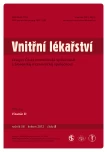Calcitriol endocrine microsystems – developmental aspects and prerequisites for their lifelong functionality
Authors:
B. Kalvachová
Authors‘ workplace:
Endokrinologický ústav Praha, ředitelka doc. RNDr. Běla Bendlová, CSc.
Published in:
Vnitř Lék 2012; 58(5): 396-399
Category:
Appendix: Vitamin D
Overview
New findings regarding the local synthesis of calcitriol, its binding on nuclear receptors and its regional tissue effects have led to discovery of its endocrine microsystems. Their application in growing organisms and their lifelong functionality provide possible preventive and treatment modalities in multiple ailments, mostly by natural and minimally expensive means.
Key words:
calcitriol endocrine microsystems – children – saturation factors – cholecalciferol daily need – supplementation
Sources
1. Borissova AM, Tankova T, Kirilov G et al. The effect of vitamin D3 on insulin secretion and peripheral insulin sensitivity in type 2 diabetic patients. Int J Clin Pract 2003; 57: 258–261.
2. Calvo MS, Whiting SJ. Overview of the Proceedings from Experimental Biology 2004 Symposium: Vitamin D Insufficiency: A Significant Risk Factor in Chronic Diseases and Potential Disease-Specific Biomarkers of Vitamin D Sufficiency. J Nutr 2005; 135: 301–303.
3. Dawson-Hughes B, Heaney RP, Holick MF et al. Estimates of optimal vitamin D status. Osteoporos Int 2005; 16: 713–716.
4. Hayes CE, Nashold FE, Spach KM et al. The immunological functions of the vitamin D endocrine system. Cell Mol Biol (Noisy-le-Grand) 2003; 49: 277–300.
5. Heaney RP. The Vitamin D requirement in health and disease. J Steroid Biochem Mol Biol 2005; 97: 13–19.
6. Holick MF. Vitamin D deficiency. N Engl J Med 2007; 357: 266–281.
7. Hollis BW. Circulating 25-hydroxyvitamin D levels indicative of vitamin D sufficiency: implications for establishing a new effective dietary intake recommendation for vitamin D. J Nutr 2005; 135: 317–322.
8. Kalvachová B. Vitamin D – nové poznatky a endokrinní mikrosystémy kalcitriolu. Osteologický Bulletin 2007; 2: 62–67.
9. Keen RW, Egger P, Fall C et al. Polymorphisms of the Vitamin D Receptor, Infant Growth and Adult Bone Mass. Calcif Tissue Int 1997; 60: 233–235.
10. McGrath J. Does „imprinting“ with low prenatal vitamin D contribute to the risk of various adult disorders? Med Hypotheses 2001; 56: 367–371.
11. Paszková H. Profylaktické a terapeutické využití vitaminu D od rachitidy přes osteoporózu až k degenerativním kloubním onemocněním. Rehabil fyz lék 2000; 7: 16–20.
12. Posonby AL, McMichael A, van der Mei I. Ultraviolet radiation and autoimmune disease: insights from epidemiological research. Toxicology 2002; 27: 71–78.
13. Vieth R. Vitamin D Nutrition and Its Potential Health Benefits for Bone, Cancer and Other Conditions. J Nutr Environ Med 2001; 11: 275–291.
14. Waterland RA, Garza C. Potential mechanisms of metabolic imprinting that lead to chronic disease. Am J Clin Nutr 1999; 69: 179–197.
Labels
Diabetology Endocrinology Internal medicineArticle was published in
Internal Medicine

2012 Issue 5
Most read in this issue
- Vitamin D metabolism
- Vitamin D and neurological diseases
- Eyelids with yellow granulomas and cough – periocular xanthogranuloma associated with adult-onset asthma. A case study and an overview of clinical forms of juvenile xanthogranuloma and its therapy
- Scoring systems to evaluate prognosis of community-acquired pneumonias
